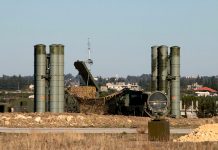
Iran’s General Director of the Aerospace Industry at the Ministry of Defense has announced that the Qaher-313 aircraft, marketed as a stealth fighter, has entered its flight test phase in an unmanned configuration. This declaration, made during the Kish International Airshow, has reignited discussions about the aircraft’s future—first revealed in 2013—and whether it will evolve beyond the theoretical ambitions of its development program.
Iran presents the Qaher-313 as a cutting-edge stealth fighter, claiming it possesses advanced capabilities such as radar evasion, low-altitude flight, and tactical operational versatility. It is also positioned as a symbol of Iran’s technological independence, aimed at establishing the country as a regional military power capable of self-reliance in defense innovation.
The design of the Qaher-313 mirrors modern stealth fighters like the F-22 and F-35, featuring sharp angles intended to minimize radar detection. However, experts have raised concerns regarding its aerodynamic properties, which may significantly undermine its performance. The sharp angles, while reducing radar cross-section, increase aerodynamic drag, leading to reduced maneuverability, especially at higher speeds. This could cause turbulence around the fuselage, resulting in energy losses and diminished stability—factors critical for combat operations.
A key issue with the aircraft’s design is the absence of traditional vertical stabilizers, which are essential for maintaining stability during high-speed maneuvers. Without these stabilizing components, the Qaher-313 may struggle with control, particularly during aggressive combat maneuvers or at high angles of attack, where rapid adjustments to flight paths are crucial. The lack of these control surfaces could severely limit its effectiveness in dynamic aerial combat situations.
Furthermore, the aircraft’s small wings may restrict its ability to generate the necessary lift during rapid maneuvers, hindering its performance in high-speed, evasive actions or tactical combat scenarios. This, combined with the aircraft’s overall aerodynamic shape, could reduce its stability and agility, which are vital for success in modern air-to-air engagements.
The Qaher-313’s compact size also raises concerns about its fuel and weapon capacity, questioning its suitability for long-range missions. The absence of detailed information regarding its key technical components—such as engines, avionics, and materials—adds to the uncertainty surrounding its operational potential. Without publicly available test data or confirmed manned flight tests, doubts persist about the aircraft’s combat-readiness.
While stealth design relies on both shape and special materials to minimize radar signatures, analysts argue that the materials used in the Qaher-313 are unlikely to meet the standards necessary for effective stealth capabilities. This, combined with the lack of evidence for successful manned flight tests, casts further doubt on the aircraft’s viability.
Many experts suggest that the Qaher-313 is more of a political symbol than a functional military asset. Amidst ongoing economic sanctions and technological challenges, Iran may be using the aircraft to project national pride and technological self-sufficiency, rather than to develop a competitive fighter jet. The project is likely intended to reinforce domestic patriotism and Iran’s standing as an independent military force in the region, despite international limitations.
While some analysts believe the Qaher-313 remains in its developmental stages, its true combat potential is uncertain. Even if completed, it is unlikely to rival advanced Western stealth aircraft like the F-22 or F-35, which offer superior speed, maneuverability, and technological sophistication. As a result, the Qaher-313 is more likely to serve as a testing platform for future developments rather than a fully operational combat aircraft.




